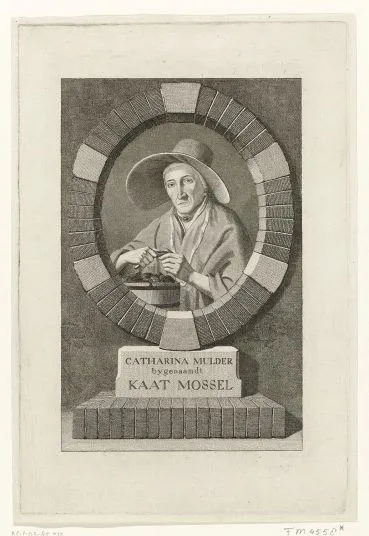Kaat Mossel: from common rioter to heroine

Arrested for rioting: it is a common way to keep aggressive football fans in check. Hooligans are often sentenced to community service, where they have to do a number of hours of unpaid work for a social organisation such as a local authority, healthcare institute or forestry agency. These are lenient sentences compared to the treatment rioters received around two hundred years ago. After Kaat Mossel, a mussel-inspector from Rotterdam, became involved in riots, she was arrested and imprisoned for many years in a dark gaol in the Prison Gate. She became a popular heroine.

Orangists versus Patriots
In the third quarter of the 18th century, a conflict arose between two groups: on the one hand, the Orangists, the ‘common folk’ who had always been faithful supporters of the House of Orange; and on the other hand, the well-to-do classes, united as the ‘Patriots’. Influenced by the Enlightenment and the French Revolution, the latter wanted a more democratic government with greater powers for citizens. Feeling in the two camps became increasingly heated. Harsh confrontations frequently occurred, at which neither group was afraid to use violence. Stadholder William V even had to quit the scene for a while, eventually fleeing the Netherlands for good as French troops approached.
Kaat the mussel-woman
A woman of humble origins, Catherina Mulder, or Kaat Mossel as she is commonly known, was born in Rotterdam in 1723. She was one of the passionate supporters of the House of Orange. Married to a dock worker, Kaat’s regular haunt was the Old Port of Rotterdam, where she inspected mussels for the city authorities and took care of their distribution.
Orangist celebrations spiral out of control
In 1783, the Orangist celebrations in Rotterdam, in which Kaat Mossel was an enthusiastic participant, spiralled out of control. There were even riots in the street. A vigilante group was formed, which also held patrols at night. During the night of 3-4 April 1784, clashes took place between Patriots and Orangists. Shots were fired into the crowd and four people were killed. A committee was subsequently formed to investigate the incident.
Kaat Mossel is arrested and spends years awaiting her sentence
Kaat Mossel was suspected of having instigated the riots. She was therefore arrested and locked up in the prison under Rotterdam’s city hall. A year later, Kaat was sentenced to a public flogging and branding with a branding iron, as well as ten years’ imprisonment in the penitentiary, followed by life banishment from Rotterdam. Her lawyer, Willem Bilderdijk, took her case on appeal to the Court of Holland.
'Kaat was then transferred to the Prison Gate, where she was imprisoned for two years whilst awaiting trial.'
In 1787, stadholder William V returned to The Hague and the Orangists regained control. Kaat was released and went back to Rotterdam, where she lived for some time in relative anonymity. She died ten years later, in 1798.
Kaat Mossel the heroine
Although she benefited little from it, Kaat was seen by many, even during her lifetime, as an example of a brave woman who defended her interests in public. People also continued to write after her long after her death; sometimes in a negative way, such as her former lawyer, Willem Bilderdijk, who depicted her as a ‘rough and common woman’ in one of his books. But accounts often portrayed her more positively as an emancipated woman. In 1904, she was the heroine of a comedy, and in 1994, the Dutch singer and actress Joke Bruijs played her in a musical. Kaat Mossel is far from being forgotten.

